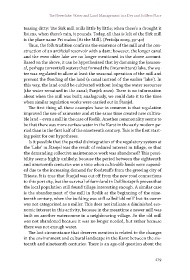Page 281 - Changing Living Spaces
P. 281
The Neverlake: Water and Land Management in a Dry and Soilless Place
teasing ditty: The Sirk mill mills little by little; when there’s a drought it
listens, when there’s rain, it pounds. Today, all that is left of the Sirk mill
is the place name Pri malnu [At the Mill]. (Peršolja 2009, 39–40)
Thus, the folk tradition confirms the existence of the mill and the con-
struction of an artificial reservoir with a dam; however, the longer canal
and the even older lake are no longer mentioned in the above account.
Based on the above, it can be hypothesized that by damming the (season-
al, perhaps torrential) waters that formed the (intermittent) lake, the wa-
ter was regulated to allow at least the seasonal operation of the mill and
prevent the flooding of the land (a canal instead of the earlier ‘lake’). In
this way, the land could be cultivated without losing the water resources
(the water remained in the canal; Panjek 2020). There is no information
about when the mill was built; analogously, we could date it to the time
when similar regulation works were carried out in Štanjel.
The first thing all these examples have in common is that regulation
improved the use of rainwater and at the same time created new cultiva-
ble land – even a mill in the case of Rodik. Another commonality seems to
be that there was more surface water in the Karst in the early modern pe-
riod than in the first half of the nineteenth century. This is the first start-
ing point for our hypotheses.
Is it possible that the partial disintegration of the regulatory system at
the ‘Lake’ in Štanjel was the result of reduced interest in tillage, so that
the demanding collective maintenance work was abandoned? This possi-
bility seems highly unlikely, because the period between the eighteenth
and nineteenth centuries was a time when cultivable lands were expand-
ed due to the increasing demand for foodstuffs from the growing city of
Trieste. It is true that Štanjel was cut off from the new road connections
to this port city, but the survival of farmland in Dol Stočajnik proves that
the local population still found tillage interesting enough. A similar case
is the abandonment of the mill in Rodik at the beginning of the nine-
teenth century, when the building was still called ‘old mill’ but its owner
was not categorized as a miller. This does not indicate a diminished eco-
nomic interest in this activity, because in the meantime a newer mill was
built on another watercourse in a neighbouring village. So the old mill
was not abandoned because it was no longer needed, but rather because
there was not enough water.
The last circumstance that deserves mention is related to the changes
in the environment and cultural landscape in the Karst between the six-
teenth and nineteenth centuries. There is an age-old question about the
279

